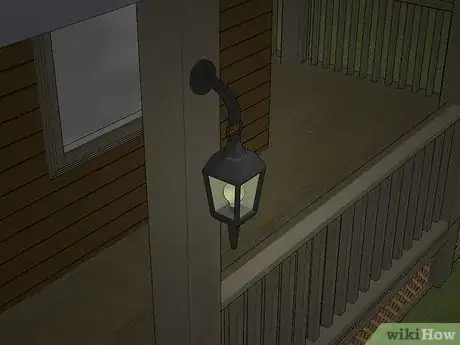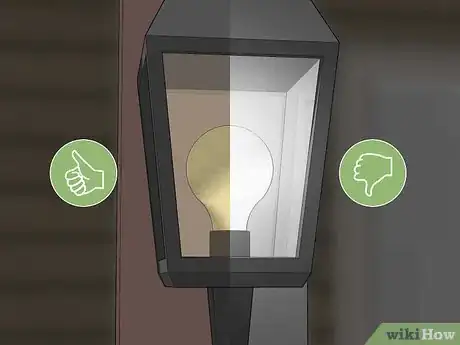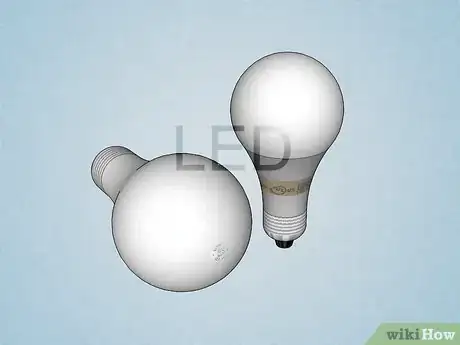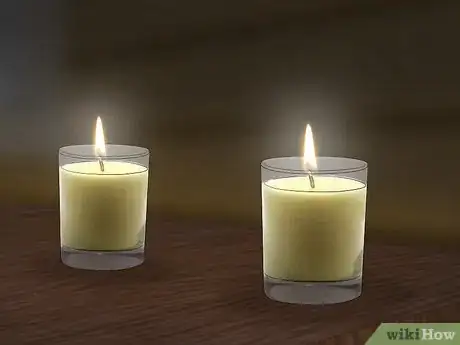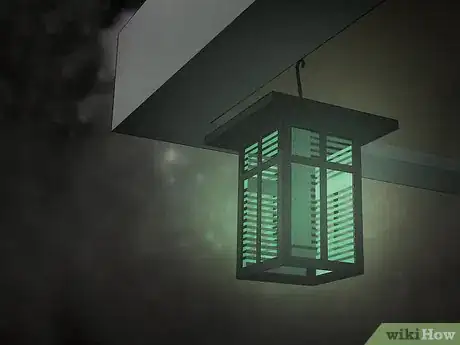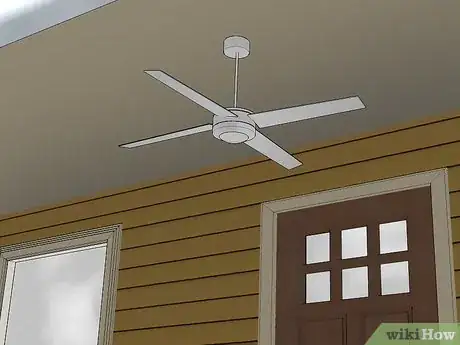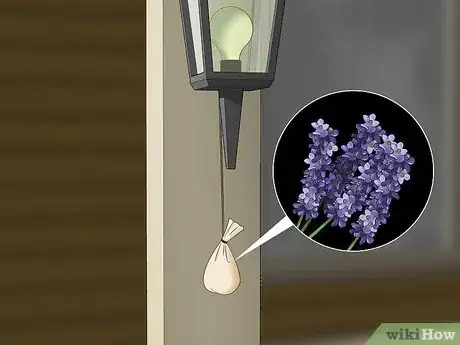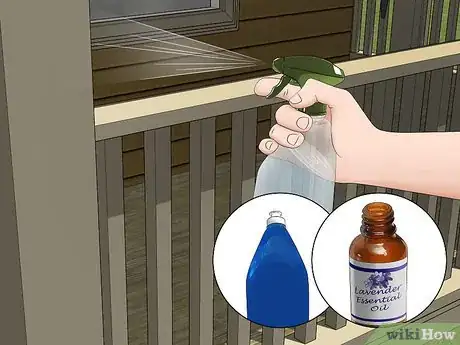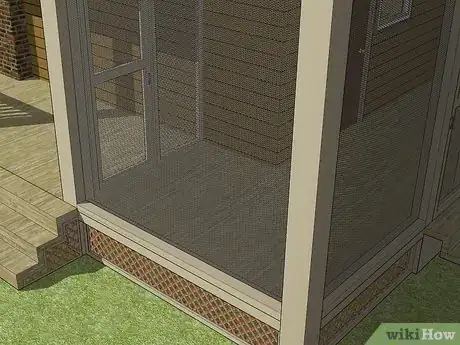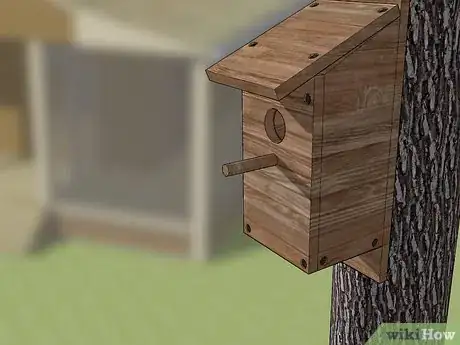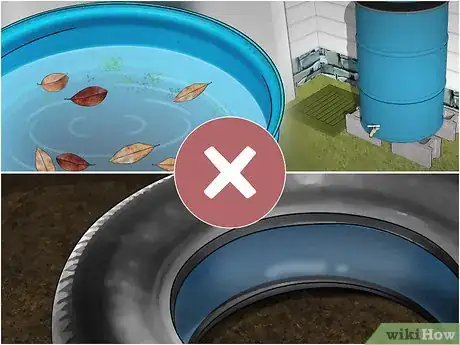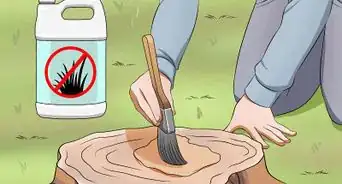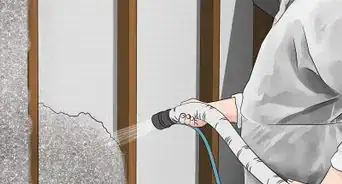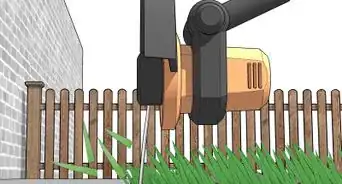This article was co-authored by Luke Lewis. Luke Lewis is a Pest Management Expert and the Founder and President of Native Pest Management. Luke has led his company for over 7 years and specializes in pet-friendly and eco-friendly pest control, termite control, and lawn care. Native Pest Management was named as one of Inc. Magazine’s 5000 fastest growing companies in America. Luke holds both BS and MS degrees from the University of Florida and is a graduate of UF's Pest Management University.
There are 11 references cited in this article, which can be found at the bottom of the page.
This article has been viewed 173,042 times.
Nobody likes opening their front door at night and immediately being swarmed by bugs, but the warm glow of the porch light seems to be a magnet for them. What’s a homeowner to do? Fortunately, there are several steps you can take to help reduce the number of unwanted insects around your entranceway. One of the simplest solutions is to switch to LED or yellow “bug” bulbs in your lighting fixtures. You can also try making the area less critter-friendly by setting out aromatic candles or spices, hanging an electric bug zapper or bird house nearby, or installing a dense screen for total protection. And, if all else fails, there’s always your trusty fly swatter!
Steps
Using Alternative Lighting Options
-
1Turn off any lights you’re not using. The heat and light given off by porch lights are like a homing beacon for bugs, which means the simplest way to thin their ranks is to leave them in the dark. Hold off on flipping the switch until there’s not enough light outside to see by. [1]
- This may not always be the most practical answer, as many homeowners prefer to leave their porch lights on overnight for safety reasons.
- Try rigging your porch lights to a timer or light sensor so that they’ll activate at dusk and shut themselves off automatically when the sun begins to rise.
-
2Try out yellow bulbs. Look for specially tinted “bug” bulbs designed to repel insects. The color yellow has one of the highest wavelengths on the visible spectrum—this makes it very hard for bugs to see. Most of them will fly right by without even noticing.[2]
- If you don’t want to go to the trouble of replacing all of your porch lights, you can also try lining the fixtures themselves with yellow cellophane to produce the same effect.[3]
- One downside of yellow bulbs is that they cast your whole house in a yellow hue. This may not be ideal if you have your sights set on winning your neighborhood’s “most beautiful home” award.
Advertisement -
3Switch to LED lights. LED bulbs emit far less heat than ordinary incandescent bulbs, and their light isn’t as attractive to insects. Most of them also put off a clean, white shine, so you won’t have to see your home awash with the sickly color generated by yellow bulbs. You’ll be able to find LED bulbs in an array of convenient sizes to suit your unique lighting needs at most hardware and home improvement stores.[4]
- LED bulbs tend to cost a little more than standard light bulbs. For this reason, it may be more economical to reserve them for fixtures nearest the main entrances and exits.
-
4Keep a few candles lit. Aromatic candles are particularly effective for warding off winged intruders. They also serve as an elegant secondary light source, making them a win-win. For best results, arrange your candles on a table or railing directly below the problematic porch light.[5]
- Look for candles containing pungent oils and additives like lemongrass, eucalyptus, peppermint, rosemary, and lavender.
- Citronella candles are among the most commonly used and effective bug-repellent lighting solutions. They can be found in most places where home and garden supplies are sold.[6]
- A sea of twinkling candles may be nice to look at, but don’t forget that they can also present a fire hazard. Make sure the candles you put out are in jars or holders, and keep them a safe distance away from curtains, upholstery, plants, and anything else that’s flammable.
-
5Invest in a bug zapper. Although there’s nothing pretty about what they do, there’s a reason these devices are a time-honored method of combating flying pests. Their mystifying blue glow lures insects in, and their electrified core finishes the job once they get close. All you have to do is hang your bug zapper up a few feet away from your porch light and let it do its thing.
- Because of the constant buzz of electricity and stench of burnt insects, bug zappers may not be the go-to solution for people who use their porch as a place of peaceful refuge.
- If you don’t like the idea of killing bugs en masse, you might be better off exploring a more humane solution.
Employing Other Deterrents
-
1Install an outdoor ceiling fan. If your home has a wrap-around style porch with an overhang, one or more fans might be just what you need. Not only will they help reduce the number of airborne critters by literally blowing them away, they’ll also keep your surroundings cooler and more hospitable during the sultry summer months.
- Keeping the air outside moving is also useful for dispersing carbon dioxide, food particles, and other human odors in the environment that brings bugs in for a closer look.
-
2Place pungent spices around the porch. Fill a few coffee filters or pieces of cheesecloth with pungent herbs and spices like cinnamon, nutmeg, bay leaf, or citrus zest and tie them off into bundles. Hang the bundles around your light fixtures, or somewhere less conspicuous, like under the eaves of the roof or behind a potted plant. Any insects in the vicinity will catch a whiff and think twice about coming any closer.[7]
- Replace the spice pouches every few days once they begin to lose their potency.
-
3Spray the area with an herbal infusion. Spices aren't the only natural turn-off for bugs. You may get equally effective results by combining essential oils like rosemary, mint, thyme, lavender, or clove oil with a small amount of soapy water and spritzing the solution in out-of-the-way spots. Just be sure to keep the liquid away from exposed wiring and other electric lighting components.
- It may be necessary to spray your herbal solution once or twice a day during the muggy summer season when insects are out in full force.
- You can also mix essential oils with a mild carrier oil like olive or coconut oil and apply them to your skin to serve as a wearable repellent.[8]
-
4Put in a screen. Tightly-woven mesh screens can provide a full-time barrier against bugs for larger porches and other outdoor sitting areas. When outfitting your porch, be sure to choose a type of screening that’s small enough to prevent gnats and other tiny nuisances from slipping through the cracks. An experienced contractor can screen-in an exposed porch in a single afternoon for as little as a couple hundred dollars.[9]
- If you’re handy with a toolbelt, you might also opt to install a screen yourself using a simple DIY system like Screen Tight.[10]
- The occasional fly or moth may still get in while the door is open, so it’s a good idea to use your screened-in porch in conjunction with a yellow light, bug zapper, or scented candle.
-
5Hang a bird or bat house nearby. Mount the house to an outlying tree, fence, or in-ground post and stick a small handful of fruit or seeds inside to entice visitors. Insects are the natural prey of most large winged creatures. By inviting them into the area, all you’re essentially doing is letting nature take its course.[11]
- Premade bat and bird houses are often available at home improvement centers and garden supply stores.
- Situate the structure far enough away from your porch to keep the occupants from congregating around your home. They’ll come out to hunt on their own when they get hungry.[12]
-
6Do away with standing water. It’s not uncommon to find insects swarming around places where water has collected. Drain small ponds, gulches, and low spots in your lawn using a surface pump, or have channels cut into the ground to promote proper runoff. Chances are, you’ll notice a big difference right away.
- If you live in an area that receives a lot of regular precipitation, consider filling in problem areas with sand, gravel, or a mixture of both. Rainwater will filter down between the sediment rather than pooling on the surface.
- Stagnant water is a favorite habitat of insects like mosquitoes that carry diseases.[13]
Community Q&A
-
QuestionI love camping and just returned from Mikumi. We use the generator and compact fluorescent bulbs but at night thousands of bugs get attracted to the bulb and ruin everything. What is the solution?
 X2slothCommunity AnswerThere are multiple ways to help (thank goodness) with all the bugs swarming your lighted area: 1. By using alternative lighting sources. 2. By using yellow tinted bulbs instead of clear. 3. By switched your bulb to a LED bulb. 4. Light a few aromatic candles. 5. Invest in a bug zapper. 6. Place pungent spices around the area. 7. Do away with still water.
X2slothCommunity AnswerThere are multiple ways to help (thank goodness) with all the bugs swarming your lighted area: 1. By using alternative lighting sources. 2. By using yellow tinted bulbs instead of clear. 3. By switched your bulb to a LED bulb. 4. Light a few aromatic candles. 5. Invest in a bug zapper. 6. Place pungent spices around the area. 7. Do away with still water.
Warnings
- Avoid using bug sprays, pesticides, or other poisonous chemicals so close to your home. These can be unsafe to, especially if you have small children or pets.⧼thumbs_response⧽
- Yellow lights aren’t guaranteed to be 100% effective. A small amount of light may remain visible to bugs with keen senses.⧼thumbs_response⧽
Things You'll Need
- Yellow light bulbs
- LED lights
- Bug zapper
- Aromatic candles
- Ceiling fan
- Mesh screening
- Bird or bat house
- Pungent herbs and spices
- Fly swatter
References
- ↑ https://www.topbulb.com/blog/will-yellow-bug-light-actually-keep-bugs-away/
- ↑ https://www.topbulb.com/blog/will-yellow-bug-light-actually-keep-bugs-away/
- ↑ https://www.youtube.com/watch?v=fZUvYos0aKA&feature=youtu.be&t=53
- ↑ http://www.vulcantermite.com/home-improvement/outdoor-lighting-options-that-wont-attract-bugs/
- ↑ https://www.houzz.com/ideabooks/1779472/list/porch-life-banish-the-bugs
- ↑ https://insectcop.net/best-citronella-candles-mosquito-candles-that-work/
- ↑ http://www.naturallivingideas.com/repel-bugs-insects/
- ↑ http://dontwastethecrumbs.com/2015/05/homemade-bug-repellent-essential-oils/
- ↑ https://www.builddirect.com/blog/buzz-off-how-to-create-a-bug-free-porch/
About This Article
One of the easiest ways to keep pesky bugs away from your porch lights is to switch out normal light bulbs for “bug” bulbs that are tinted yellow. Since yellow has one of the highest wavelengths on the visible spectrum, these light bulbs are hard for bugs to see so most of them will fly right by. If you don’t want to go around swapping out all of your bulbs, try lining your light fixtures with yellow cellophane to get the same effect. Another option is switching to LED lights, as these emit a lot less heat and aren’t as attractive to insects. Consider choosing LED bulbs if you don’t like yellow colored bulbs and can afford the slightly higher cost per bulb. For more tips, like how to attract insect-eating birds to your property, scroll down!
